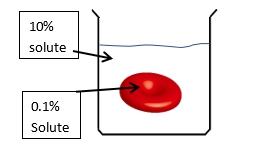In this video, we're going to do a quick refresher on osmosis. So you guys know that osmosis is simply a type of diffusion. And diffusion is the movement of a substance from a high concentration down to lower concentrations of the same substance. And osmosis again is a specific type of diffusion. Osmosis is the diffusion of a solvent across a semipermeable membrane or a membrane that allows some substances to cross but prevents other substances from crossing. The solvent is usually going to be water, especially in biological systems. Osmotic pressure is the pressure that's required to prevent the flow of the solvent. Osmotic pressure is really a measure of the strength of osmosis. So the higher the osmotic pressure, the greater the strength of osmosis. Now, in our next video, we're going to talk about the direction of osmosis. But before we get there, it's important to note that the direction of osmosis depends on the tonicity of the solution. Recall that tonicity refers to the relative concentrations of solutes, not solvents, that are dissolved in the solutions. There are three different terms that refer to the tonicity of a solution: isotonic, hypotonic, and hypertonic.
Isotonic refers to a solution that has the same solute concentration as another solution. Solute concentration is important because tonicity refers to solute, not solvent concentration. The next term is hypotonic. Hypotonic sounds like low, hypo, low. Hypotonic solutions have lower solute concentrations than another solution. The opposite of hypotonic is going to be hypertonic. When I think of hyper, I think about a kid that's had way too much sugar and they're just running around all over the place. Because they've had too much sugar, hyper, this is a solution that has a higher solute concentration than another solution. These three terms are words of comparison, so you can only use them when comparing one solution to another solution.
In our example below, we're going to compare the outside solution of a cell to the inside solution of a cell, which is separated by a plasma membrane. In our first scenario of our example, the outside solution, which is in light blue, is separated by a semipermeable membrane and the inside solution is in a yellowish like orangeish brownish mustard color. We have these green solutes that are dissolved. Notice that the outside solution has a lower solute concentration than the inside solution because there are fewer green dots in a certain area. Because the outside solution has a lower solute concentration, it's going to be hypotonic in comparison to the inside solution. Over here in the next scenario, notice that the concentration of solutes, these green dots here, is exactly the same on the outside and the inside solution. So that means that the outside solution is isotonic with respect to the inside solution. In our final scenario over here, notice that the outside solution has a much greater solute concentration than the inside. Because the outside has a higher solute concentration, it's going to be hypertonic. The tonicity here is going to control the direction of osmosis. We'll talk about the direction of osmosis in our next video. So, I'll see you guys then.



